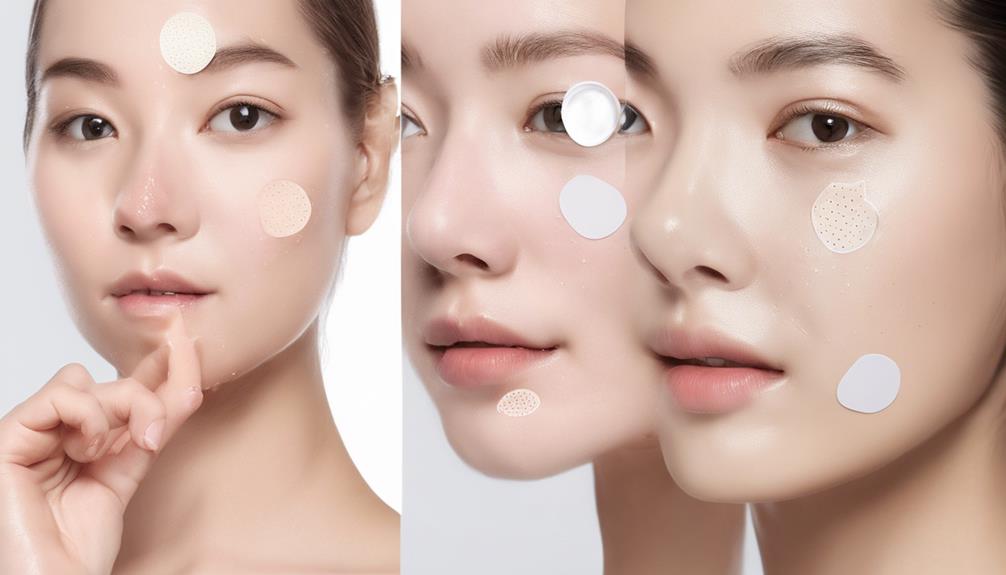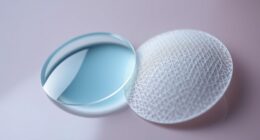Pimple patches usually don't cause scarring when you use them correctly; in fact, they help heal blemishes and protect your skin. However, if you misuse them—like applying them to non-inflamed pimples or picking at your skin—they can lead to increased inflammation and scarring. Leaving patches on too long can irritate your skin as well. To get the most out of your pimple patches, it's important to understand their proper use and benefits.
Key Takeaways
- Pimple patches generally do not cause scarring when used correctly; they promote healing and protect blemishes.
- Misuse, such as applying patches on non-inflamed pimples or picking at them, can lead to increased inflammation and scarring.
- Leaving patches on for too long may cause irritation and hyperpigmentation, potentially leading to scarring.
- Proper application techniques, like ensuring clean and dry skin, help minimize the risk of scarring.
- Combining patches with other treatments should be done cautiously to avoid irritation, which can contribute to scarring.
Understanding Pimple Patches and Their Purpose
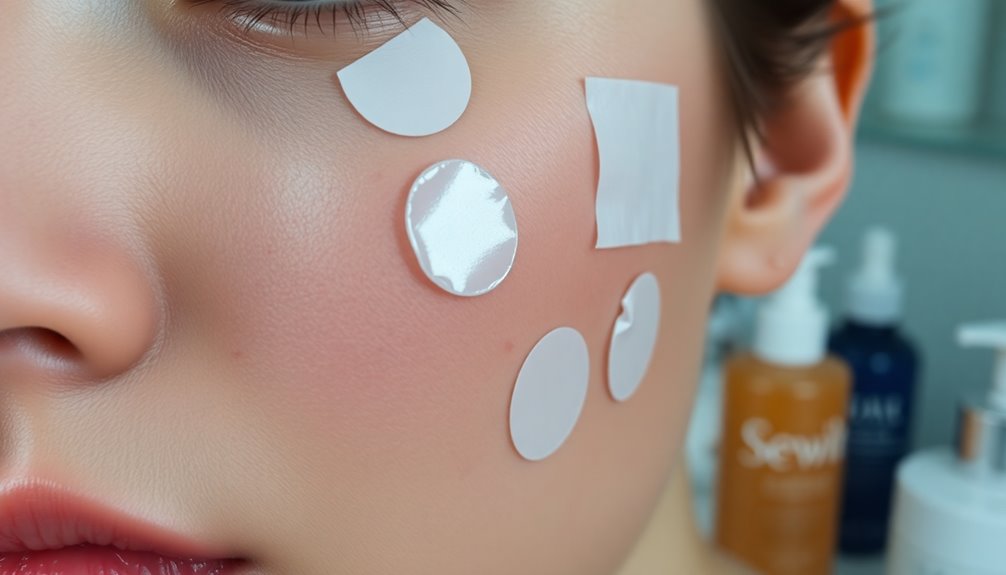
When you're dealing with a breakout, pimple patches can be a game-changer. These adhesive stickers are designed to stick directly over your pimples, promoting healing while protecting the area from bacteria.
Made from hydrocolloid material, pimple patches absorb excess fluid, pus, and oil, creating a moist environment that aids in healing and minimizes scarring. They come in various sizes, ensuring you can find the perfect fit for any pimple without it being too noticeable. Regular skin treatments can further enhance the effectiveness of pimple patches by improving overall skin health.
The primary purpose of these patches is to reduce the risk of scarring by keeping you from picking at your skin and providing a protective barrier that lessens inflammation and irritation. Additionally, the use of pimple patches exemplifies how creative practice can enhance personal care routines.
While they won't fix existing scars, they can help prevent new ones during the healing process.
Do Pimple Patches Leave Scars?
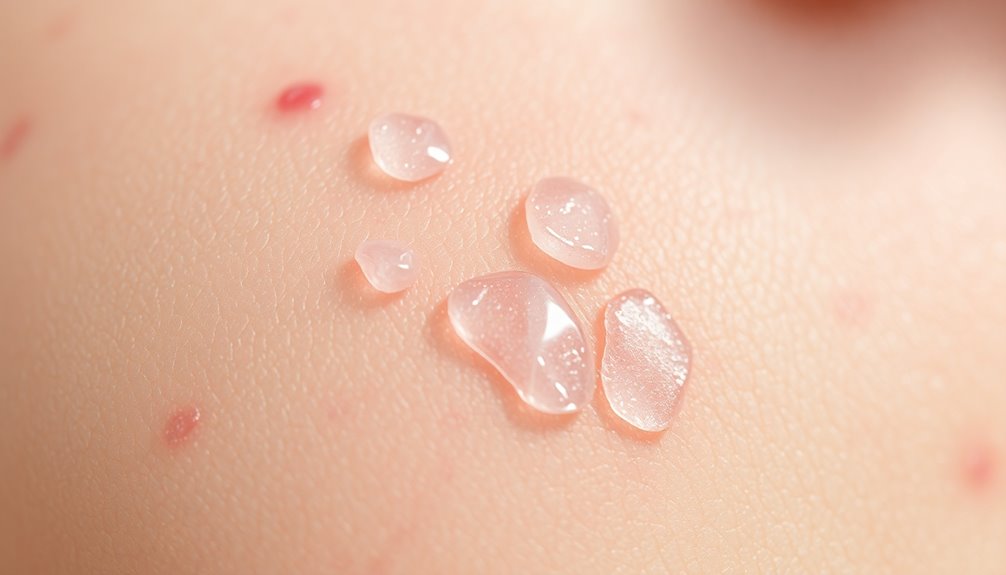
Pimple patches can be a great ally in your skincare routine, but you might wonder if they can leave scars. Typically, when used correctly, pimple patches don't cause scarring. They promote healing and create a protective barrier over blemishes, which helps absorb excess fluid from acne breakouts. This process can minimize the risk of further skin damage. Additionally, the use of glycolic acid can enhance skin texture and tone, further supporting the healing process.
However, individual skin responses can vary. Misusing patches—like applying them to non-inflamed pimples or manipulating the acne beneath—can lead to increased inflammation and potential scarring.
To avoid irritation and maximize healing, choose patches with gentle ingredients and always follow product instructions. When used properly, pimple patches are effective tools for managing acne without leaving scars behind. Additionally, using patches that contain salicylic acid or hydrocolloid technology can enhance their effectiveness in treating stubborn acne.
When Do Pimple Patches Cause Scarring?
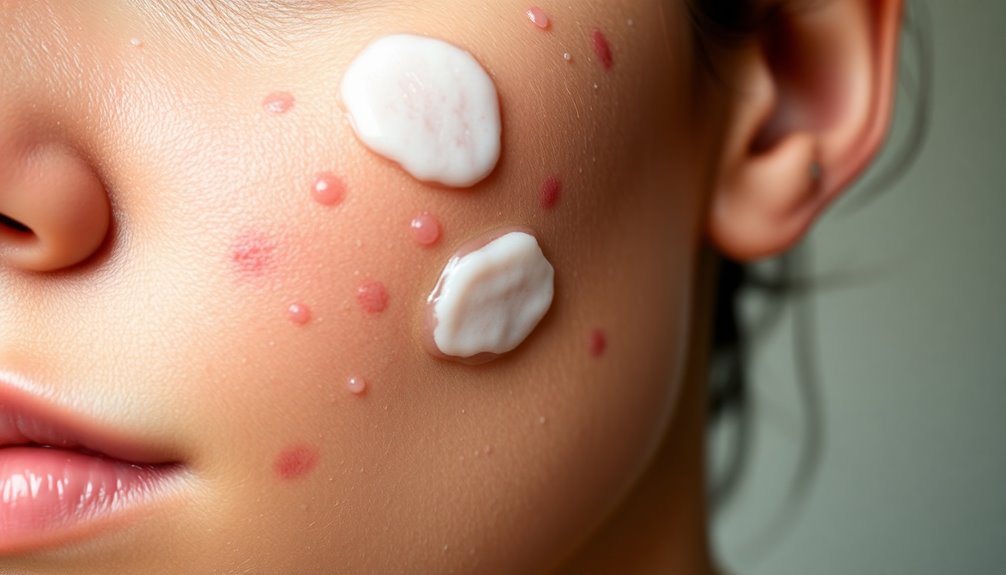
Using pimple patches incorrectly can lead to scarring, especially if you apply them to early-stage breakouts or irritate your skin further. If you pick at pimples while wearing patches, you risk intensifying inflammation and worsening your skin's condition. Additionally, some patch ingredients might irritate your skin, increasing the chance of scarring if not used properly. A balanced diet rich in nutrients can help support skin health and potentially reduce the likelihood of scarring. Furthermore, maintaining adequate sleep is essential for skin recovery and overall health, which can also play a role in minimizing scarring.
Misuse and Manipulation Risks
While pimple patches can be effective for treating blemishes, misusing them can lead to unwanted scarring. Applying patches to non-inflamed pimples or picking at them increases irritation and heightens the risk of skin damage. Leaving patches on for too long, or using harsh adhesives, can also contribute to post-inflammatory hyperpigmentation and scarring. To avoid these issues, follow proper usage guidelines and treat your skin gently. Additionally, using patches made with hydrocolloid technology can promote healing and reduce the chance of scarring. Furthermore, maintaining a clean environment and improving air quality can help minimize skin irritation and support overall skin health.
| Misuse Scenario | Resulting Issue | Risk of Scarring |
|---|---|---|
| Applying to non-inflamed | Increased irritation | High |
| Picking at pimples | Exacerbated inflammation | Very High |
| Long patch duration | Skin irritation | Moderate |
| Harsh adhesives | Allergic reactions | High |
Irritation From Patch Ingredients
Misuse can lead to scarring, but irritation from patch ingredients is another significant factor to contemplate.
Pimple patches often contain active ingredients like salicylic acid, which can irritate sensitive skin. While these ingredients aim to reduce inflammation, they may cause redness or further irritation in some individuals. In cases of prolonged irritation, the skin's barrier can be compromised, making it more susceptible to narcissistic abuse from environmental factors.
The adhesive used in patches can also create allergic reactions if left on too long. To avoid complications, always follow application guidelines, like patch testing and adhering to recommended wear times.
Remember, manipulating or picking at pimples while using patches can exacerbate inflammation, increasing scarring risks. Additionally, using products with glycolic acid may provide exfoliation benefits that can help with skin clarity and texture, potentially reducing the likelihood of scarring.
How Pimple Patches Help Prevent Scarring
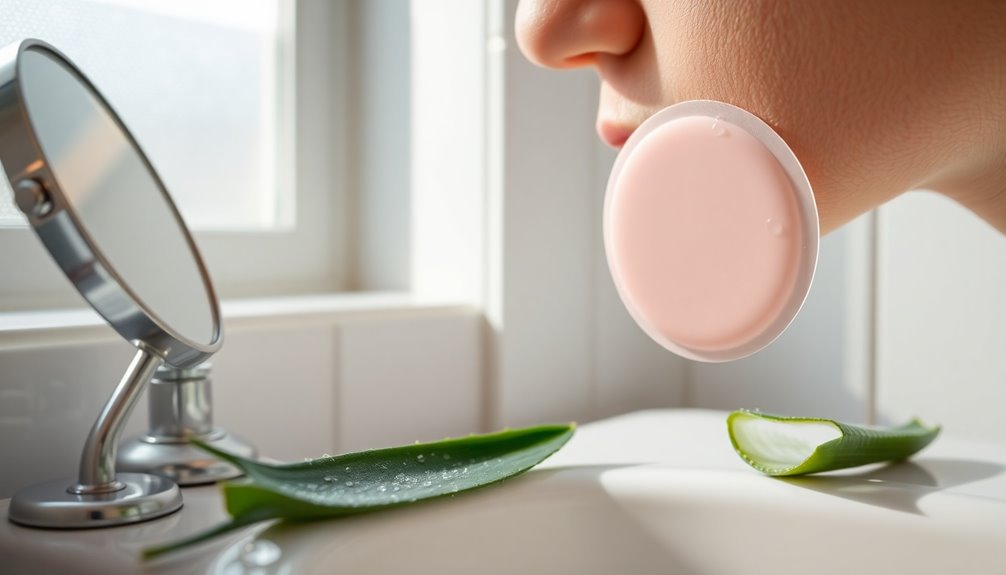
Pimple patches effectively help prevent scarring by creating a protective barrier over blemishes, which discourages you from picking at them.
These patches absorb excess fluid, pus, and oils, promoting a moist environment that enhances the healing process and reduces inflammation.
By shielding your skin from UV light, pimple patches also lower the risk of post-inflammatory pigmentation (PIH), a factor that can lead to noticeable scars.
In addition, microdart patches deliver collagen-stimulating factors directly into your skin, aiding in regeneration and improving texture.
Regular use of pimple patches greatly reduces the likelihood of scarring by protecting healing spots and maintaining conditions conducive to scarless wound healing.
With consistent care, you can keep your skin looking smooth and flawless.
Common Mistakes That Lead to Scarring
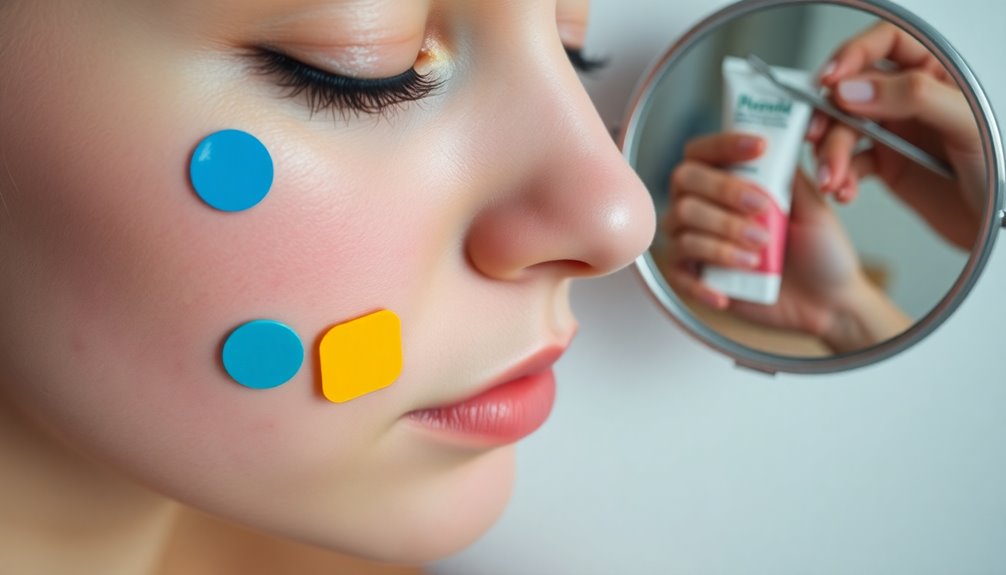
When it comes to preventing scarring, making common mistakes can greatly hinder your efforts.
Applying pimple patches on non-inflamed or early-stage pimples can block proper healing and increase scarring risk. If you don't clean your hands and face before applying patches, you risk introducing bacteria, leading to inflammation and potential scars.
Using patches on wet or oily skin prevents them from adhering properly, leaving blemishes unprotected and vulnerable to scarring. Additionally, leaving patches on for over 24 hours can irritate your skin, exacerbating inflammation and scarring likelihood.
Finally, manipulating pimples while using patches can worsen inflammation and damage the skin, considerably raising the risk of scarring.
Avoid these mistakes to protect your skin effectively.
Proper Application Techniques for Pimple Patches

Before you apply pimple patches, make sure your skin and hands are clean and dry.
Choosing the right patch size is essential for proper placement, as it needs to fully cover the pimple to be effective.
Cleaning Before Application
Cleansing your face and hands thoroughly is essential for the effective application of pimple patches. Proper cleaning removes dirt, oil, and bacteria that could lead to irritation or infection, ensuring the best treatment for your acne.
Follow these steps for ideal results:
- Use a gentle, non-comedogenic cleanser to prepare your skin.
- Rinse your face with lukewarm water to avoid irritation.
- Pat your skin dry with a clean towel to keep it moisture-free.
- Avoid applying patches on wet or oily skin for better adhesion.
Correct Patch Placement
After confirming your skin is clean and dry, the next step is to focus on the correct placement of your pimple patches.
Choose a patch size that completely covers the pimple to create an effective barrier. This maximizes the absorption of fluids and impurities, which is essential for healing.
Press the patch down firmly to eliminate air bubbles and guarantee it adheres to the skin properly. This not only enhances its effectiveness but also helps prevent scarring.
Leave the patch on for the recommended duration, usually several hours or overnight, to allow it to work.
When it's time to remove the patch, do so gently to minimize irritation and protect the surrounding skin.
Ingredients in Pimple Patches That May Cause Irritation

Many pimple patches contain ingredients that can irritate your skin, especially if you have sensitivities.
It's important to be aware of these components before using them. Here are four common ingredients that might irritate the skin:
- Salicylic Acid: Effective but can cause redness if overused or applied on irritated areas.
- Tea Tree Oil: While antibacterial, it may lead to allergic reactions for some individuals.
- Adhesives: Prolonged use or sensitivity to certain adhesives can result in irritation.
- Hydrocolloid: Generally safe, but using it on broken skin may increase irritation and scarring.
To minimize the risk of irritation, always perform a patch test on a small area before using new pimple patches.
The Role of Hydrocolloid in Wound Healing
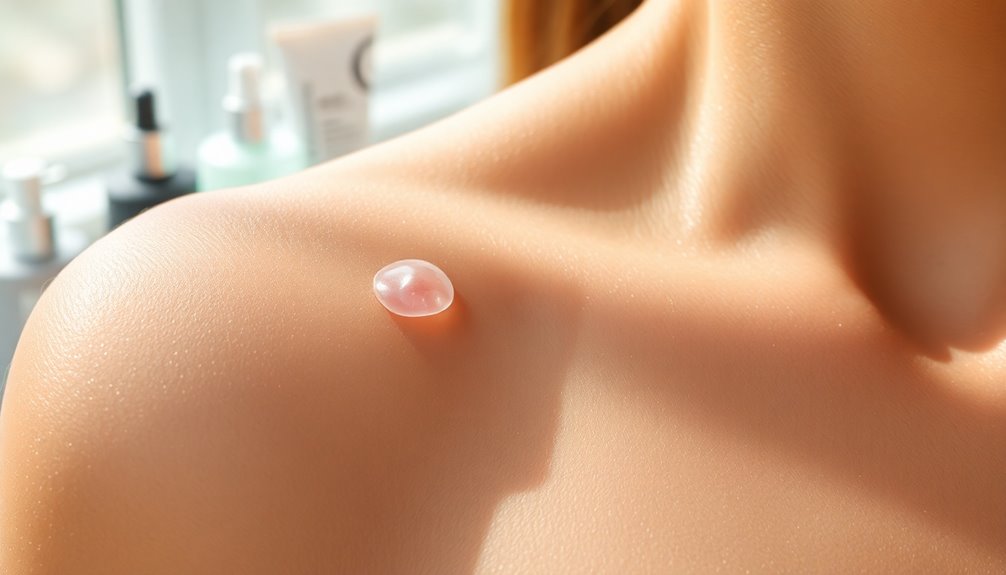
When it comes to wound healing, hydrocolloid patches play an essential role by creating an ideal moist environment that accelerates recovery.
These patches absorb excess fluid, preventing scab formation, which can hinder the healing process. By acting as a protective barrier, hydrocolloid patches reduce the risk of infection from external contaminants.
They also decrease inflammation and irritation, vital factors for minimizing scarring. When the hydrocolloid material interacts with moisture, it forms a gel-like substance that maintains skin hydration, further aiding in healing.
Studies show that using hydrocolloid patches can flatten raised scars and improve the overall appearance of healing wounds. Embracing this technology can meaningfully enhance your skin recovery journey.
Combining Pimple Patches With Other Acne Treatments

Combining pimple patches with other acne treatments can greatly enhance your skincare routine, especially if you're aiming for quicker healing and reduced inflammation.
Here are some effective ways to do this:
- Topical Treatments: Use pimple patches alongside salicylic acid or niacinamide to boost inflammation reduction.
- Hydration: Apply hydrocolloid patches on fresh breakouts to retain moisture and absorb excess fluid, maximizing results.
- Evening Routine: Incorporate retinol or vitamin C serums at night while using pimple patches during the day to improve texture and help prevent scarring.
- Microdart Patches: Consider microdart patches to deliver active ingredients deeper, targeting scarring and pigmentation more effectively.
Always cleanse your skin before applying patches, and avoid layering too many products to prevent irritation.
Seeking Professional Help for Acne and Scarring
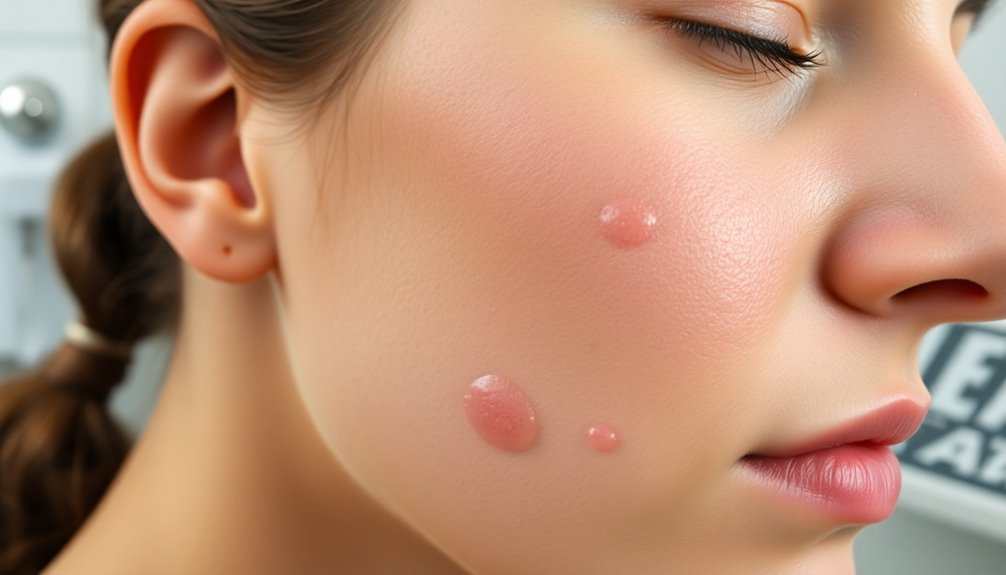
While using pimple patches can be effective, addressing persistent acne and scarring might require professional guidance. Consulting a dermatologist is essential for tailored treatment plans, which may include chemical peels, laser therapy, or prescription medications.
They can identify underlying causes of your acne, like hormonal imbalances, guaranteeing you receive effective management strategies. A dermatologist can also recommend the best use of pimple patches within your skincare routine to prevent potential scarring while promoting healing.
Regular follow-ups allow for adjustments based on your skin's response, enhancing the overall success of your acne treatments. Seeking professional help not only optimizes your approach but also guarantees you're combining treatments effectively for the best results in managing acne scarring.
Frequently Asked Questions
Do Pimple Patches Still Leave Scars?
Picture a shield guarding a castle; that's what pimple patches do for your skin. If you use them correctly, they shouldn't leave scars. They absorb fluid and protect blemishes, reducing irritation.
However, if you misuse them—like applying on non-inflamed spots or picking at your skin—you might increase inflammation, risking scars.
Stick to the instructions and choose gentle products to minimize irritation and keep your skin smooth and clear.
Can Pimple Patches Damage Your Skin?
Pimple patches can damage your skin if you don't use them correctly. If you apply them too tightly or on non-inflamed skin, you might irritate your skin.
Ingredients like salicylic acid can also lead to reactions if you have sensitive skin. Leaving patches on for too long can trap bacteria, worsening breakouts.
To avoid damage, always make certain your skin is clean and dry before applying the patches, and follow the instructions carefully.
Why Does My Pimple Patch Leave a Mark?
If your pimple patch leaves a mark, it might be due to skin sensitivity or irritation from ingredients like salicylic acid.
Harsh adhesives can also cause redness if the patch is left on too long. You should always follow the instructions and avoid using patches for extended periods.
Consider patch testing on a small area first to see how your skin reacts, which can help minimize any unwanted marks after removal.
How Do You Get Rid of Pimple Patch Scars?
Did you know that up to 80% of people experience acne at some point?
To get rid of pimple patch scars, start by using silicone sheets or gels that help heal and flatten scars over time. Incorporate topical treatments with retinol or vitamin C for better skin texture.
Regular chemical peels can exfoliate and boost collagen. Finally, consider microneedling for deeper scars. Consulting a dermatologist's key for personalized advice!
Conclusion
In the grand scheme of your skincare journey, pimple patches can be your gentle allies, helping to shield blemishes and promote healing. While they typically won't leave scars, missteps in their use might lead to unwanted reminders on your skin. By treating your skin with care and combining patches with other treatments thoughtfully, you can maintain a clear canvas. If you're ever in doubt, consider reaching out to a professional—they can provide the guidance you need to achieve your skincare goals.


